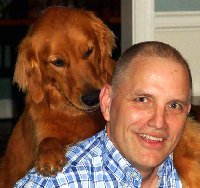The question that often comes to mind is, “What caused the dog to act like this?” In the case of an adoption the reason will probably never be known. It could be a breed characteristic, a traumatic event or abuse. Whatever the cause, it is something that needs to be corrected for your dog to resume a normal life.
It is instructive to think about something you were personally very fearful of. Was it heights, public speaking, the boss? Whenever that fear was, your emotional state changed when you were confronted. Your mental state went from calm to being on guard (overly focused), self-protective (fight) or wanting to actively avoid the situation (flight). Now think about how you overcame a fear. Most likely it was by repeatedly facing up to the fear until it was no longer bothersome. It never diminished by avoiding it.
Your dog only knows how to avoid, be on guard or be self-protective. It doesn’t have the wherewithal to “face its fears.” That is where you, the handler, come in. For the dog to recover from a fearful situation, it has to gently and slowly be made to face up to the fear until it realizes that the fearful behavior is no longer warranted.
How to Help Your Dog Through a Fearful Situation
Do it gradually and do it in a way that your dog can understand. Let’s use an example of a dog that is fearful of other dogs. Perhaps it was attacked at some point in its life and now it either hides or acts up when another dog approaches. Since we are talking about communicating with your dog – let’s review HOW to communicate effectively.
Dogs Don’t Talk
Obvious right? However most owners believe speaking to the dog is the best way to communicate. We think that if we say something often enough & loud enough the dog will understand. Over time, that is mostly true. However with a fearful dog, who is under immediate stress, it is far better to become more primal with communications.
Primal Language
Dogs are pack animals with a strong alpha leader. There is always an alpha leader dog. If you aren’t the alpha leader for your dog, then HE WILL AUTOMATICALLY ASSUME HE IS THE ALPHA LEADER. The alpha leader keeps the peace, makes the decisions, enforces the rules and does what he pleases. Body language and attitude provide the majority of the communication. Dogs use physical acts such as bumping, blocking, growling, confronting and occasionally biting to magnify and reinforce their position and express their wishes.
Take These Two Steps
Step one – reestablish you as the alpha leader.
Show him that you are the one in charge and that you make ALL the decisions and he is to follow. You decide when to walk, when to stop, who goes out the door first, when to be quiet and settled, etc. The more you are perceived as an alpha leader, the more secure your dog will be.
A word here about being an alpha leader – as such, you are NOT rough, loud or overly physical. It does however convey that you mean what you say and do. If the dog is to walk beside your knee and not out front, it means that you convince your dog that that is how it is going to be, no exceptions. Use your physical presence to convey this message the way dogs do to each other (see above – with the exception of biting).
The ideal place to establish the leader position is on a daily walk. Rein the dog in such a way that he is walking beside your knee and not wandering off on a long leash. His “job” is to be by your side. You decide the speed, direction and duration of the walk. Walk with your head up as if your dog isn’t even there. This will encourage the dog to follow and begin seeing you as the alpha leader.
Step two – take tiny steps towards facing the fearful problem.
Continuing with our example of fear of other dogs, ask a friend or neighbor to stand with another dog at a distance where your dog IS NOT fearful. That is the distance where your dog does not feel threatened. Now walk toward the friend’s dog until you get a fearful reaction. Now at this point invoke your role as the alpha leader. You ask your dog to settle down by using your hand in his face or on his hind quarters or tugging the leash until his focus is back on you. Stay there until you get him settled. If after a few minutes of trying he just won’t settle, then move back to the safe distance and move in again.
Each time your dog settles down the next attempt can be closer and closer until the dogs are together. It is not up to your dog whether he ultimately meets another dog. It is up to you as the alpha leader. What you are doing is giving him a chance to adjust to your demand. If you are a strong alpha leader, your dog will ultimately trust your judgment and realize there is nothing to fear.
Dogs live “in the moment.” I’m always surprised how quickly a dog will accept a new reality. If the new reality is that we routinely walk up to other dogs in a calm, confident manner then they accept that new reality. It becomes the new recording in their head. The old recording has been erased and is gone.
You can adapt this technique to any fearful situation whether it is loud trucks, crowds or the vet’s office. Remember the two keys. Be the strong alpha leader and take small steps toward the object of fear.

